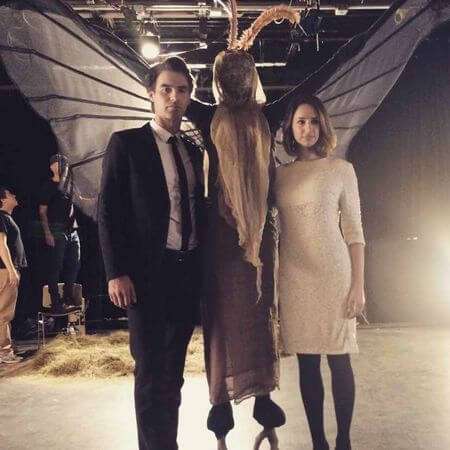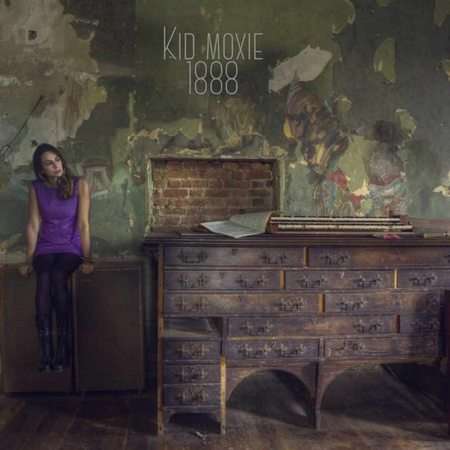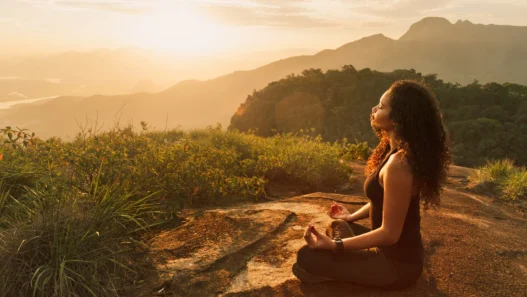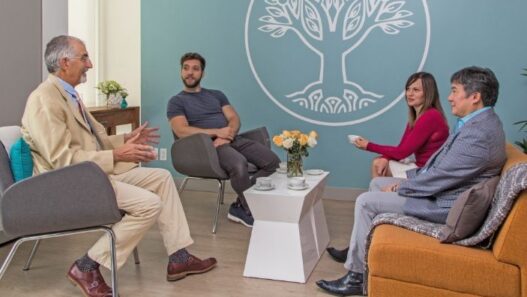The sounds and images Elena Charbila aka Kid Moxie creates are hauntingly beautiful. So is the way she perceives the world and expresses it… Find out what inspires Elena’s life and learn how she re-made the iconic Blue Velvet theme “Mysteries of Love,” in a successful collaboration with Angelo Badalamenti himself!
 Mix music and movies, then leave it up to the universe
Mix music and movies, then leave it up to the universe
You are both an actress and a musician, do you just take it as it comes or set certain time periods to prioritize one role over the other?
I take it as it comes, I don’t think about it much. In this industry you really never know where you’ll be taken next.
I kind of have left it up to the universe. I don’t feel that is a fatalistic thing to say – it’s actually very trusting because you feel like ‘okay, I’m putting this out and putting this out and I feel confident that wherever this leads I am going to walk that path that I have already set’.
There have been times when acting has taken more precedence, and there have been times when music has led the way. I try to combine them, because one of my biggest loves is what we just did with “Mysteries of Love”: creating a piece – well, Angelo Badalamenti really created it, I just interpreted it – and putting an image to it, a visual interpretation on it. So you combine the love of performing and setting a story into music.
How did this collaboration with Angelo Badalamenti come about?
I have been a huge Lynch/Badalamenti fan, already since my teens. That whole world they had created was so inspiring and dense. There was just so much atmosphere to go in, so many feelings to take away from it. I was drenched in all these emotions when I was watching these two artists collaborate.

At some point I sent Angelo some of my music. I did not think he was going to respond, but he emailed me and said he really loved what he heard and gave me beautiful feedback that was both helpful and encouraging.
A little while later he called me and said, “I have something for you, are you coming to New York any time soon?” So a few months later we met in this labyrinth building where they were doing a screening he was watching to potentially score music for. He was just so warm and gave me a big hug. Until this day I always say that Angelo is one of the most magical people I have ever met.
We went for a drive listening to the new rendition of “Mysteries of Love” he had just recorded in Belgium with a full orchestra. He said, “Do you want to do this together?”
It was both exhilarating and frightening – here is somebody whom you hugely admire and for years you have explored his work, had so many feelings created by it, and suddenly he is asking you to do something together! It was a pivotal moment because it was so fulfilling for me personally.
So, I took the song with me to Los Angeles and I think I did about 67 takes because I’m really OCD and I wanted to get it just right. And he loved it! He was generous enough to let me use it for my new album, 1888.
Exploring mysteries of life
The remake of “Mysteries of Love” is such a beautiful work of art also in its visual form. How was the video born? What were the ideas and feelings you wanted to express with it?
In December I called Michael Sternfeld, my co-producer, and said, ‘Let’s put a dream team together and make a beautiful video for “Mysteries of Love” because it’s such an iconic song and there’s never been a video for it and I just feel we have to do it!’
So we put a team together, asking Amine Kouider, an alumnus of David Lynch M.A. in Film, Sam Lieb, the head of DLF TV, and Donald Revolinski from Maharishi University of Management, to join us.
I first started telling those guys that for me the energy behind this song was the merging of darkness and light. It’s an attractive theme in general because there’s always the other side of the coin – it’s love and fear, darkness and light and everything in between that leads to each side. And it’s about love, the darkness of love and the light of love.
 I knew I wanted to start it in a forest because in our collective subconscious it is a magical place, a pure canvas for anything to happen.
I knew I wanted to start it in a forest because in our collective subconscious it is a magical place, a pure canvas for anything to happen.
So I said, “We need a forest. It’s about darkness and light and a girl who is going to find a shaft of light coming from underneath the earth.” Because it is just a beautiful scene – you don’t expect to find light coming from the earth!
Then we started brainstorming how it’s going to come about and everyone just put in a beautiful piece of their own feelings about how they wanted to construct this end result we see – this Mystery of Love which we don’t really solve, only explore. In fact, there is no need to solve it because some mysteries just don’t call for a resolution; they just are there for to be part of and to explore.
These are the feelings behind starting this video. We had a lot of help from MUM students from the M.A. in Film program, and the TM community in general.
We were so rushed to do this because we knew David was going to do a concert on April 1st. It was a long shot – we did not think we would be including it, but decided to give it a try anyways. ‘Let’s just speed up, do it the best way we can, and see what happens!’
We only had 10 days to edit and put it all together before the concert. We sent in a rough draft, David approved it and it became the only music video shown during the concert which, as you might have heard or read from the media, was a crazy amazing night.
He personally congratulated us later and said we had done a great job. It was just really meant to be the way it was.
Where did the idea for the butterfly and the cocoon come from?
The lady inside the cocoon is a renowned performance artist, Susie B. Woods. Her performance of a cocoon turning into a butterfly is also part of the permanent exhibition at MoMa.
Amine had shot her performing before and we thought it would be great if people could watch something unravel like love unravels, takes you in and transforms you. It is also a bit scary; it is not just beautiful and pretty.
That imagery was actually sort of disturbing until you saw the resolution – her emerging as a butterfly, which made it a beautiful symbol.
I’m really happy you are saying that because the whole goal for me was to make something that it’s not just, ‘Oh, these people are getting together and it’s all beautiful and they are experiencing this gorgeous performance together.’ No. You want to show the layers of the disturbing, and the enthralling, the enlightening and the scary.
It is the core of the video because it is the whole symbolism of it. Amine thinking of Susie Woods and bringing her in was such an amazing addition. It wouldn’t have been the same without her in it.
WATCH VIDEO: Angelo Badalamenti feat. Kid Moxie, “Mysteries Of Love”
Moving (into) the deeper layers…
It might be an unfair question to pose to an artist but do you have special favorites among the songs from your album, 1888?
I understand that the ones I love are the ones I can keep listening to. Yet I’ve listened to all of them so many times! I’m so OCD that it’s perhaps more than I should have.
Yet obviously, “Mysteries of Love” is one of the central pieces for me because of its story and because of Angelo. It symbolizes so much in my heart, both as a song and a story. It brings such light to have it on the album.
Every song is a scene, representing something that hasn’t happened. What’s very inspiring for me is not what you’ve lived but what you’d like to live. It’s not like, ‘Oh, I’ve had this experience and I’m going to write about it!’ It’s more like, ‘There’s this experience I’d like to have and because I don’t have it I’m going to write about it to live it.’ No song is based on anything that’s actually happened, it’s all imagination.
 “Lacuna” is the first song of the album and it is the song that started it all, so I have a unique feeling about that. The song is about the myth of Narcissus in Greece, but with a twist of how I would have imagined him looking at his reflection. Maybe there’s a monster standing behind him and he’s looking at a monster in the lake!
“Lacuna” is the first song of the album and it is the song that started it all, so I have a unique feeling about that. The song is about the myth of Narcissus in Greece, but with a twist of how I would have imagined him looking at his reflection. Maybe there’s a monster standing behind him and he’s looking at a monster in the lake!
There’s “The Bailor,” which is based on T.S. Eliot – across the album, there’re a few lines I have taken from T.S. Eliot and spun them into my own stories.
“Museum Hotel” is another one that is very orchestral and at first I thought I wanted to write a soundtrack to a swamp – you know, how it would be to stand by a swamp at night. I started from that and saw that the swamp was probably by a beautiful mountainside. We did a video that reflected that feeling; there’s darkness and there’s water between mountains and a girl emerges, and transforms into a mountain. It carries this feeling of emerging.
” You want to show the layers of the disturbing, and the enthralling, the enlightening and the scary… “
What I’m trying to say is that these stories are serving the atmosphere, because atmosphere is the compass. It’s not about what’s happening, really; it’s rather about how you want to feel.
The way you describe this creative process is so fascinating. It seems like a whole different mode of thinking.
I think it’s very unique for everyone. People that create have a sort of a need to express and be heard, not necessarily understood. Some want to be understood, others don’t, but I think everybody has their own unique path. That’s why art, thank god, is also so different!
Nowadays, especially what regards pop music; there are just so many similarities. You hear similar things, see similar things. There’s over-saturation of what pop music is these days. I think if people were really trying to express what is unique in them, there would be a little bit more diversity and uniqueness. Right now, there still is some of that, but it gets a little bit lost and smudged in the mainstream culture. But I guess that’s fine! (smiles)
Would you agree that what distinguishes this kind of soul-felt work you do is that the audience will not just be entertained, but also moved on some deeper level?
It better move something! (laughs)

You have donated your music to the David Lynch Foundation, which raises funds to teach Transcendental Meditation to at-risk populations. You practice TM yourself. When and how did meditation practice become part of your life?
I write in the arts section of what’s probably the most prominent newspaper in Greece. It’s sort of my diary – stuff that I find inspiring, conversations with people. About six years ago, I wrote about a long talk on meditation and creativity that I had with David Lynch.
The conversation really inspired me to see what it was that he was talking about. So, I decided that for my next birthday I was going to give myself the gift of Transcendental Meditation.
For me it’s really the only meditation technique that works because it does not go against the grain of your brain. Your brain is made to think, it’s easier to stop a truck than to stop your brain. So the fact that it embraces that flow in your brain was something that made me say immediately, ‘This is it and this is maybe the only it, as far as meditation goes!’
It does not feel like you need to force yourself into going somewhere, it just happens naturally. It’s natural, easy and makes sense. Before that I would just try to switch my thinking off, or think of something else, and it would just not produce any of the results I wanted!
Has practicing TM changed the way you perceive the world in any way you can pinpoint?
It definitely enhanced my experience and my focus: knowing what drives me and knowing how to get there. And trusting it. I feel like when you are connected to that silence and when you experience that – sometimes I call it nothingness, which is kind of everythingness – when you have that, it enhances your intuition, without any real conscious planning done, about how to get to your desired place.
My focus and my trust in my inner core instinct and strength: those two are definitely the two big ones that TM has contributed to.
And just that whole feeling… I think it was for the first time while doing the practice that I experienced the feeling of nothingness. By definition almost, you don’t reflect on that during that specific moment, but a second later you feel puzzled: ‘What was that?! I have never felt nothing before!’ (laughs)
” Your brain is made to think, it’s easier to stop a truck than to stop your brain. “
That, I think, is extremely powerful as a feeling —this peace of nothingness, which connects you to everythingness. Again, there are the two polarities: darkness and light, love and fear, everything and nothing. You experience that through TM.
 How do you manage to fit the 2x 20 minutes of meditation into your hectic schedule? In your work you must depend on so many other people whether in a record studio or a movie set.
How do you manage to fit the 2x 20 minutes of meditation into your hectic schedule? In your work you must depend on so many other people whether in a record studio or a movie set.
I think it’s actually easier that my schedule is not so linear. I see that I don’t have 20 minutes here, but I’m going to have it there. I’ve never really had an issue with finding the time.
Of course, it was pretty cool when we shot “Mysteries of Love” in Fairfield. Everybody knew that everybody had to take time to meditate! I’d never experienced this before on a production set.
Working with a whole group of meditators was just so different. There was a common understanding and a level of deep enjoyment and focus and trust, which was kind of unmatched before.
Going back to the beginning: Was choosing a career in music and film industry a conscious choice for you? How did you come to it?
As a young kid in Greece, I was doing music and performing in theater and television. I was three or four when I started playing the piano. All throughout elementary school I thought I was going to be a pianist.
Then, around when I was 13, I completely rebelled against what I had been doing so far. I said, ‘I hate the piano! I hate ballet! I hate theater! I want to play the drums and I don’t want to have anything to do with this anymore!’
So, my brother taught me to play the drums. I thought all these girly things like French lessons, piano, ballet — they were to be completely eradicated from my life.
Yet I came back to them during my first year of college in London. I studied film in Guildhall and with a new mind, appreciation and hunger to learn it, I realized that although not knowing exactly how it was going to be, I just wanted to be part of it.
In general, in my life, when something draws me in, I don’t know how I want to be involved, but I just know I have to be there. And I follow that intuition, and it kind of leads the way.
So I started watching a lot of films again and thinking of doing acting again. Moving to the States, I did my Masters in Theater in San Francisco. I got involved in performance, started doing piano and even ballet again, believe it or not! (laughs)
I always say that the stuff we love as kids, there is such wisdom in it because it is unbiased. What you love when you are a kid is so true to your core, because all the voices around you are not as loud. You just hear what’s inside.
So I always aspire to go back to that. It’s not easy but I know it holds a key to the truth of our core.

So you play the piano and the drums?
And I play the bass as well. It’s one of my favorite instruments because I feel it’s the spine in any music. It blends together the rhythm and the melody. It’s also what you hear the most from afar and you don’t hear it that much from up close. It’s such a magical instrument and I felt I simply had to learn the mystery of the bass.
And once you started writing you own music you were also “forced” to start singing, right?
I really did not feel I wanted to sing. I thought playing music was more fun. But when I moved to L.A. and started writing my own stuff, I felt that since there was no one around who could perform it the way I had it in my head, well, I just had no other option but to do it myself! People were responding to it in a certain way and I was like, ‘You know what, maybe it does not sound so bad, maybe I can just do it myself!’ So, I started singing out of necessity and then I actually started liking it.
” What you love when you are a kid is so true to your core, because all the voices around you are not as loud. You just hear what’s inside. “
Your album 1888 came out in December. What is up next on your agenda for the coming months?
This summer I’m going to Greece for three months, recording more music over there and a new video, possibly in Russia. I’m releasing a new album of re-mixes of 1888 a couple of weeks from now. There are a couple of movies that are doing really well in festivals and a potential new movie in Greece. So I’m exploring all these different avenues, as always!
Thank you, Elena, for this inspiring interview!

TAKE A LOOK AT THIS, TOO:
- iTUNES: download album, 1888
- VIDEO: premiere by VICE
- KID MOXIE on Facebook and Twitter









 Mix music and movies, then leave it up to the universe
Mix music and movies, then leave it up to the universe








